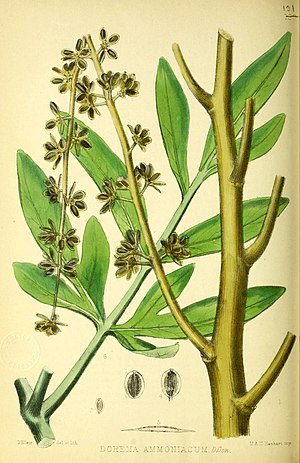Note: This is a project under development. The articles on this wiki are just being initiated and broadly incomplete. You can Help creating new pages.
Difference between revisions of "Dorema ammoniacum"
| (One intermediate revision by the same user not shown) | |||
| Line 1: | Line 1: | ||
| − | + | [[File:Dorema ammoniacum.jpg|thumb|right]] | |
| − | + | '''Dorema ammoniacum''' is a perennial plant that can grow up to 2.50 metres tall. | |
| + | It is harvested from the wild for local use as a medicine and source of materials.. | ||
==Uses== | ==Uses== | ||
| − | {{Uses|}}, {{Uses|}}, {{Uses|}}, {{Uses|}}, {{Uses| | + | {{Uses|Chronic bronchitis}}, {{Uses|Asthma}}, {{Uses|Catarrh}}, {{Uses|Swellings of the joints}}, {{Uses|Indolent tumours}}. |
==Parts Used== | ==Parts Used== | ||
| Line 17: | Line 18: | ||
===Dravya=== | ===Dravya=== | ||
===Rasa=== | ===Rasa=== | ||
| − | |||
===Guna=== | ===Guna=== | ||
| Line 30: | Line 30: | ||
==Habit== | ==Habit== | ||
| − | {{Habit|}} | + | {{Habit|Perennial}} |
==Identification== | ==Identification== | ||
| Line 49: | Line 49: | ||
==Mode of Propagation== | ==Mode of Propagation== | ||
| − | {{Propagation|}} | + | {{Propagation|Seeds}} |
==How to plant/cultivate== | ==How to plant/cultivate== | ||
| − | <ref name="How to plant/cultivate"/> | + | Easily grown in an ordinary garden soil. Prefers a well-drained to dry soil in a sunny position.<ref name="How to plant/cultivate"/> |
==Commonly seen growing in areas== | ==Commonly seen growing in areas== | ||
| − | {{Commonly seen|}}, {{Commonly seen| | + | {{Commonly seen|Loess loams in desert areas}}, {{Commonly seen|Dry rocky areas}}. |
==Photo Gallery== | ==Photo Gallery== | ||
<gallery class="left" caption="" widths="140px" heights="140px"> | <gallery class="left" caption="" widths="140px" heights="140px"> | ||
| − | + | File:Dorema ammoniacum.jpg | |
| + | File:Dorema ammoniacum - Köhler–s Medizinal-Pflanzen-201.jpg | ||
</gallery> | </gallery> | ||
==References== | ==References== | ||
<references> | <references> | ||
| + | <ref name="chemical composition">[Chemistry]</ref> | ||
| + | <ref name="Leaf">[Morphology]</ref> | ||
| + | <ref name="How to plant/cultivate">[http://temperate.theferns.info/plant/Dorema+ammoniacum Cultivation]</ref> | ||
| − | |||
| − | |||
| − | |||
| − | |||
| − | |||
| − | |||
</references> | </references> | ||
==External Links== | ==External Links== | ||
| − | * [ ] | + | * [https://pfaf.org/user/Plant.aspx?LatinName=Dorema+ammoniacum Dorema ammoniacum on pfaf.org] |
| − | * [ ] | + | * [https://www.ncbi.nlm.nih.gov/pmc/articles/PMC5333480/ Dorema ammoniacum on ncbi.nlm.nih.gov] |
| − | + | ||
[[Category:Herbs]] | [[Category:Herbs]] | ||
[[Category:Pages without herbs images]] | [[Category:Pages without herbs images]] | ||
Latest revision as of 11:48, 29 April 2020
Dorema ammoniacum is a perennial plant that can grow up to 2.50 metres tall. It is harvested from the wild for local use as a medicine and source of materials..
Contents
- 1 Uses
- 2 Parts Used
- 3 Chemical Composition
- 4 Common names
- 5 Properties
- 6 Habit
- 7 Identification
- 8 List of Ayurvedic medicine in which the herb is used
- 9 Where to get the saplings
- 10 Mode of Propagation
- 11 How to plant/cultivate
- 12 Commonly seen growing in areas
- 13 Photo Gallery
- 14 References
- 15 External Links
Uses
Chronic bronchitis, Asthma, Catarrh, Swellings of the joints, Indolent tumours.
Parts Used
[[:Category:Herbs with used in medicine|]], stem, leaves, Root.
Chemical Composition
Common names
| Language | Common name |
|---|---|
| Kannada | |
| Hindi | |
| Malayalam | |
| Tamil | |
| Telugu | |
| Marathi | |
| Gujarathi | |
| Punjabi | |
| Kashmiri | |
| Sanskrit | |
| English |
Properties
Reference: Dravya - Substance, Rasa - Taste, Guna - Qualities, Veerya - Potency, Vipaka - Post-digesion effect, Karma - Pharmacological activity, Prabhava - Therepeutics.
Dravya
Rasa
Guna
Veerya
Vipaka
Karma
Prabhava
Habit
Identification
Leaf
| Kind | Shape | Feature |
|---|---|---|
Flower
| Type | Size | Color and composition | Stamen | More information |
|---|---|---|---|---|
| {{{5}}} |
Fruit
| Type | Size | Mass | Appearance | Seeds | More information |
|---|---|---|---|---|---|
Other features
List of Ayurvedic medicine in which the herb is used
Where to get the saplings
Mode of Propagation
How to plant/cultivate
Easily grown in an ordinary garden soil. Prefers a well-drained to dry soil in a sunny position.[3]
Commonly seen growing in areas
Loess loams in desert areas, Dry rocky areas.
Photo Gallery
References
- ↑ [Chemistry]
- ↑ [Morphology]
- ↑ Cultivation
External Links
- Ayurvedic Herbs known to be helpful to treat Chronic bronchitis
- Ayurvedic Herbs known to be helpful to treat Asthma
- Ayurvedic Herbs known to be helpful to treat Catarrh
- Ayurvedic Herbs known to be helpful to treat Swellings of the joints
- Ayurvedic Herbs known to be helpful to treat Indolent tumours
- Herbs with used in medicine
- Herbs with stem used in medicine
- Herbs with leaves used in medicine
- Herbs with Root used in medicine
- Habit - Perennial
- Index of Plants which can be propagated by Seeds
- Herbs that are commonly seen in the region of Loess loams in desert areas
- Herbs that are commonly seen in the region of Dry rocky areas
- Herbs
- Pages without herbs images


